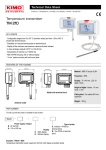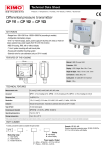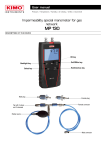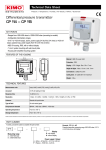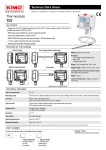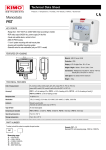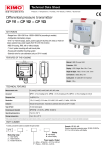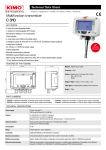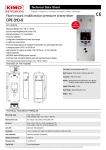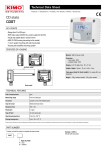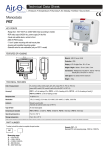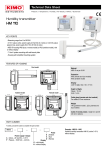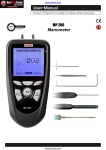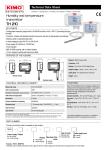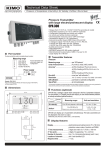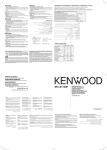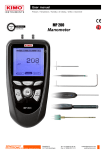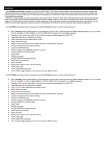Download CP 210 - Interautomatika
Transcript
Temperature and differential pressure transmitter CP 210 KEY POINTS - Range from -100/+100 Pa to -2000/+2000 mbar (according to, see “Part number”) - Input Pt100 on terminal block for temperature measurement, range from -100 to +400 °C (probes as option) - Configurable intermediate ranges - 4 wires analogue output 0-5/10 V or 0/4-20 mA - Power supply 24 Vdc/Vac or 115/230 Vac - Trend indicator - ABS V0 housing, IP65, with or without display - “¼ turn” system mounting with wall-mount plate - Solenoid valve for auto-calibration (only on CP211 and CP212 models) FEATURES OF THE HOUSING 59.2 mm 125 mm Material : ABS V0 as per UL94 Protection : IP65 Display : 75 x 40 mm, LCD 19 digits 2 lines. 115 mm Height of digits : Values : 10 mm ; Units : 5 mm Connection : Ribbed Ø 6.2 mm (CP211/212) Compression for tubes Ø4x6 mm (CP213/214/215) Pass-through : for cables Ø 6 mm maximum Cable gland : for cables Ø 8 mm maximum Weight : 320 g PART NUMBER To order, just add the codes to complete the part number : Example : CP 211 – HO Pressure transmitter -100/+100 Pa measuring range, with power supply 115 or 230 Vac, with display CP 21 Display O : with display N : without display Measuring range 1 : -100/+100 Pa 2 : -1000/+1000 Pa 3 : -10 000/+10 000 Pa 4 : -500/+500 mbar 5 : -2000/+2000 mbar Power supply / Output B : 24 Vac/Vdc H : 115 or 230 Vac TECHNICAL FEATURES Units of measurement CP211/212/213 : Pa, mmH2O, mbar, inWG, mmHG, daPa, kPa, hPa CP214 : mbar, mmH2O, kPa, inWG, mmHG, hPa, daPa, PSI CP215 : mbar, mmH2O, kPa, inWG, mmHG, hPa, daPa, PSI, bar CP211/212/213/214/215 (température Pt100) : °C / °F Accuracy* CP211/212 : ±0.5% of reading ±2 Pa ; CP213 : ±0.5% of reading ±10 Pa ; CP214 : ±0.5% of reading ±0.5 mbar CP215 : ±0.5 of reading ±2 mbar CP211/212/213/214/215 (Pt100 temperature) : ±0.5 % of reading ±0.5 °C Response time 1/e (63%) 0.3 s Resolution CP211/212/213 : 1 Pa ; 0.1 mmH2O ; 0.01 mbar ; 0.01 inWG ; 0.01 mmHG ; 0.1 daPa ; 0.001 kPa ; 0.01hPa CP214 : 1 mbar ; 1 mmH2O ; 0.1 kPa ; 0.1 inWG ; 0.01 mmHG ; 1 hPa ; 10 daPa ; 0.01 hPa CP215 : 1 mbar ; 1 mmH2O ; 0.1 kPa ; 0.1 inWG ; 0.01 mmHG ; 1 hPa ; 10 daPa ; 0.01 hPa ; 0.001 bar Tolerated overpressure CP211/212 : 21 000 Pa – CP213 : 69 000 Pa – CP214 : 1400 mbar – CP215 : 4100 mbar *All the accuracies indicated in this technical datasheet were stated in laboratory conditions, and can be guaranteed for measurements carried out in the same conditions, or carried out with calibration compensation. TECHNICAL SPECIFICATIONS Power supply 24 Vac / Vdc ±10 % 115 Vac or 230 Vac ±10 %, 50-60 Hz Output 2 x 4-20 mA or 2 x 0-20 mA or 2 x 0-5 V or 2 x 0-10 V (4 wires) Maximum load : 500 Ohms (0/4-20 mA) Minimum load : 1 K Ohms (0-5/10 V) Galvanic isolation Inputs and outputs (115 Vac/230 Vac models) Outputs (24 Vac/Vdc models) Consumption 5 VA Electromagnetical compatibility EN61326 Electrical connection Screw terminal block for cables 2.5 mm2 PC communication Kimo USB-Mini Din cable Environment Air and neutral gases Autozero Manual by push-button ; Automatic by solenoid valve (only CP211/CP212) Type of fluid Air and neutral gases Operating temperature From 0 to +50 °C Storage temperature From -10 to +70 °C CONFIGURABLE INTERMEDIATE OR CENTER ZERO RANGES Transmitter Pressure range Air velocity range* CP211 -100/+100 Pa From 3 to 10 m/s CP212 -1000/+1000 Pa From 3 to 30 m/s CP213 -10 000/+10 000 Pa From 3 to 100 m/s CP214 -500/+500 mbar Not available CP215 -2000/+2000 mbar Not available *These air velocity ranges are given for information, based on a Debimo differential probe (Cm = 0.81) and do not take into account temperature compensation. AIR FLOW AND AIR VELOCITY FUNCTION (available option on CP211, CP212 and CP213 instruments) Class 210 transmitters have 2 analogue outputs that correspond to both displayed parameters. It is possible to activate one or two outputs and select for each output between pressure, air velocity and air flow (functions as option). Linked to a differential pressure device (Debimo blade, Pitot tube, orifice plate, …), they can be equipped as option with the SQR 3 function (square root function) allowing to calculate the air velocity and/or air flow in a duct from a differential pressure. Features Measuring ranges Units and resolutions From 3 to 100 m/s (according to model) 0.1 m/s – 0.1 fpm Functions Air velocity* 3 From 0 to 100 000 m /h (according to air velocity and section) Air flow* 1m3/h – 0.1 m3/s 0.1l/s – 1 cfm *Differential pressure device (Pitot tube, Debimo...) as option ● Air velocity calculation : ρ= V =C M PO 287.1×(Θ+273.15) √ 2Δ P ρ With : CM : differential pressure device coefficient - Pitot tube type L : CM = 1.0015 - Pitot tube type S : CM = 0.84 -Debimo blade : CM = 0.8165 Θ : given temperature (°C) PO : given atmospheric pressure (Pa) Air flow calculation : Air flow (m3/h) = air velocity (m/s) x surface (m²) x 3600 Surface : setting of duct type (rectangular or circular) and duct size (mm or inch). ● INTEGRATION OF PRESSURE MEASUREMENT The pressure measurement element is very sensitive and reacts to pressure changes. When making measurements in unstable air movement conditions, the pressure measurement may fluctuate. The integration coefficient (from 0 to 9) makes an average of the measurements and then helps avoid any excessive variations ; it guarantees a stable measurement. CONNECTIONS Analogue outputs (a) DIP switch (d) Power supply type of the transmitter (b) Solenoid valve (only on CP211/212) Power supply terminal block (c) LCC-S software connection Autozero (a) Analogue output 1 (out 1) Pressure connections Analogue output 2 (out 2) Cable glands (c) (c) or GND – Ground 0/4-20 mA – Current 0-5/10 V – Voltage GND – Ground 0/4-20 mA – Current For power supply 230 Vac, 115 Vac models For power supply 24 Vac models For power supply 24 Vdc models 0-5/10 V – Voltage (c) or Ground Neutral (N)~ Phase (L)~ Neutral (N)~ Phase (L)~ + ELECTRICAL CONNECTIONS – as per NFC15-100 standard This connection must be made by a qualified technician. To make the connection, the transmitter must not be energized. Before making the connection, you must first check the power supply indicated on the transmitter board (see (b) on “Connections” part). ➢ Power supply 24 Vdc ➢ The selection of the output signal in voltage (0-10 V or 0-5 V) or in current (4-20 mA or 0-20 mA) is made via the DIP switch (d) of the electronic board of the transmitter : put the on-of switches as shown in the table below : For transmitters with 24 Vdc power supply : - - + + Configurations ~ ~ Vac N~ Vac L~ 230 Vac ➢ N L 0-5 V 0-20 mA 1 2 3 4 1 2 3 4 1 2 3 4 1 2 3 4 Connection of the output in current 4-20 mA : 0/4-20 mA + - ➢ Connection of output in voltage 0-10 V : 0-5/10 V + - 0/4-20 mA N L For transmitters with 115 or 230 Vac power supply : A Ground Power supply 115 / 230 Vac ➢ 0-5/10 V ou Pe N L Power supply 0-10 V Combinations For transmitters with 24 Vac power supply : Power supply 24 Vac class II ~ Pe N 230 Vac L ~ 4-20 mA Neutral Phase V Regulator display or PLC/BMS passive type Regulator display or PLC/BMS passive type 4-20 mA output 0-10 V output AUTOZERO Auto-calibration CP210 transmitters have a temperature compensation of the gain from 0 to 50°C and an auto-calibration process that guarantees over the time an excellent stability and a perfect reliability of the measurement on low and high ranges. Auto-calibration principle : the microprocessor of the transmitter drives a solenoid valve that compensates the possible drifts on the sensitive element over the time. The compensation is performed by the permanent adjustment of the zero. So the measurement of the differential pressure is then independent from the environmental conditions of the transmitter. Advantage : no drift Frequency of auto-calibration : resetable or from 1 to 60 minutes CONFIGURATION OF THE TRANSMITTERS It is possible on the class 210 to configure all the parameters managed by the transmitter : units, measuring ranges, outputs, channels, calculation functions, etc, via different methods : ● Keypad for models with display : a code-locking system allows to secure the installation (See class 210 user manual). ● Software (optional) on all models. Simple user-friendly configuration. See LCC-SD user manual. Configurable analogue output : Range with central zero (-50/0/+50 Pa), with offset zero (-300/0/+70 Pa) or standard range (0/+100 Pa), it is possible to configure your own intermediate ranges. Caution : the minimum difference between the high range and the low range is 20. Configure the range according to your needs : outputs are automatically adjusted to the new measuring range 0 +100 -100 0 -100 +100 50 New range 10 V 20 mA 0V 4 mA 10 V 20 mA 75 mm MOUNTING 37.5 mm 8 mm A 4.5 mm 14 mm 50 mm Once the transmitter is installed and powered up, please make an autozero to guarantee the correct working of the transmitter in any position. 40 mm 23.75 mm To mount the transmitter, mount the ABS plate on the wall (drilling : Ø6 mm, screws and pins are supplied). Insert the transmitter on the fixing plate (see A on the drawing beside). Rotate the housing in clockwise direction until you hear a “click” which confirms that the transmitter is correctly installed. A 7.5 mm CALIBRATION Adjusting and calibration on site : The professional configuration interface, with a dynamic pressure calibration bench, enables you to adjust and calibrate your transmitters directly on site or in laboratories. Outputs diagnostic : With this function, you can check with a multimeter (or on a regulator / display, or a PLC / BMS) if the transmitter outputs work properly. The transmitter generates a voltage of 0 V, 5 V and 10 V or a current of 4 mA, 12 mA and 20 mA Certificate : Class 210 transmitters are supplied with adjusting certificates. Calibration certificates are available as an option. MAINTENANCE Please avoid any aggressive solvent. Please protect the transmitter and its probes from any cleaning product containing formalin, that may be used for cleaning rooms or ducts. OPTIONS AND ACCESSORIES ● ● ● LCC-S : configuration software with USB cable SQR/3 function (square root for the measurement of air velocity and air flow) Calibration certificate ● ● ● Connection tube Connection fittings Through-connections ● ● Straight connections Spherical coupling nut 68 mm 0V 4 mA FTang – transmitter_CP210 – 04/04/13 – RCS (24) Périgueux 349 282 095 Non-contractual document – We reserve the right to modify the characteristics of our products without prior notice. Autozero To perform an autozero, unplug the 2 pressure connections tubes and press the “Autozero” key. On CP211 and CP 212 transmitters, it is not necessary to unplug the 2 pressure connection tubes. When an autozero has been performed, “On” green light turns off then turns on, and on transmitters equipped with a display, “autoZ” is displayed.




